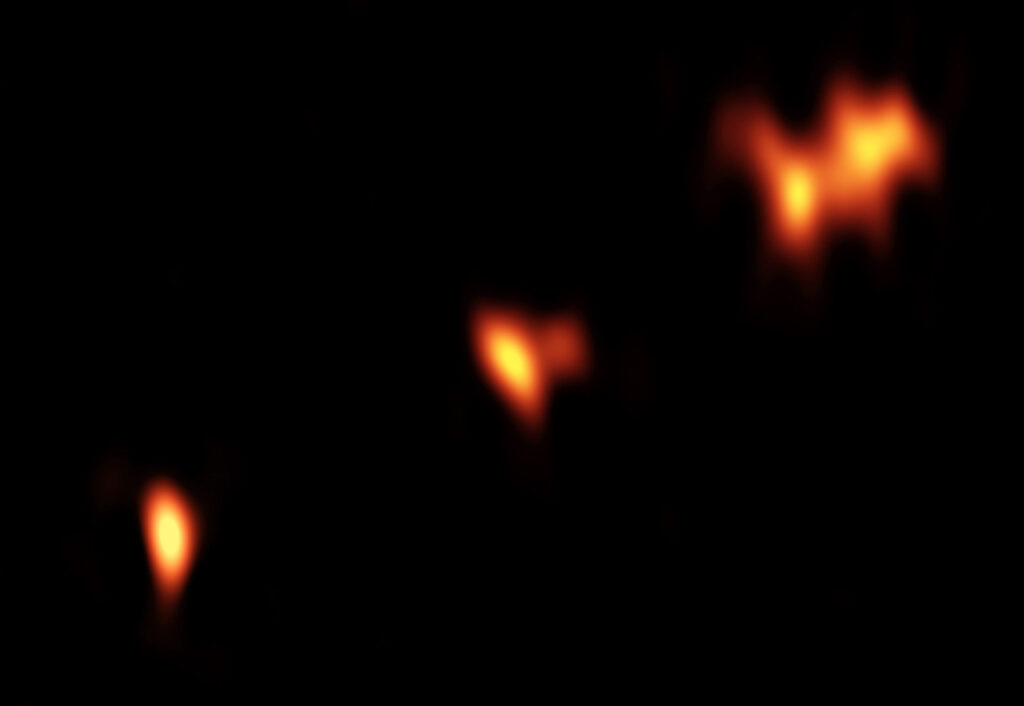
A Journey Through Time: The Biggest Radio Jet from the Early Universe
When we think about outer space, it often feels like a realm full of mysteries and wonders that humans are still trying to unravel. Scientists are like cosmic detectives, peering into the vastness of the universe to uncover its secrets. One of the most exciting recent discoveries is the detection of a gigantic radio jet, which is like a stream of energy shooting out from a quasar, a type of distant celestial object. What makes this discovery extra special is that this quasar hails from the early universe—specifically, it’s from a time when the universe was just a baby, less than 1 billion years old!
But what exactly is a radio jet? And why is this particular one so important? Let’s dive into the fascinating world of astronomy to learn more about this extraordinary find.
What is a Quasar?
To fully appreciate the significance of this discovery, we need to understand what a quasar is. Quasars are among the brightest and most energetic objects in the universe. Think of them as cosmic lighthouses, shining intensely in the darkness of space. A quasar is powered by a supermassive black hole—a region of space where gravity is so strong that nothing, not even light, can escape from it.
In a quasar, as gas and dust fall into the black hole, they spiral around it, gaining speed and heat, which causes them to emit enormous amounts of energy. This energy can be in the form of visible light, ultraviolet radiation, and yes, even radio waves, which is what makes radio jets possible.
Quasars were particularly abundant in the young universe, and they help astronomers study what the universe was like billions of years ago. Imagine trying to understand your own family history by looking at photos from when your grandparents were young. Quasars serve a similar purpose—providing astronomers with snapshots of the universe’s past.
The Phenomenon of Radio Jets
Now, let’s talk about radio jets. When a quasar emits energy, it doesn’t just do so evenly in all directions; rather, it can produce massive jets that shoot out into space. These jets are streams of charged particles traveling close to the speed of light, creating radio waves that can be detected by powerful telescopes on Earth.
The newly discovered radio jet measures over 200,000 light-years across. To put that in perspective, our entire Milky Way galaxy spans about 100,000 light-years in width. That means this radio jet is twice as wide as our galaxy! It’s like standing on the beach and spotting a colossal wave coming toward you—only this wave is made of energy and founded in the depth of space, far beyond what we can see with the naked eye.
Discovering the Giant Jet
Finding this massive radio jet wasn’t easy. The universe is filled with all sorts of radiation that can obscure what we’re trying to observe. One of the major obstacles is the cosmic microwave background radiation (CMBR), which can be thought of as the leftover energy from the Big Bang—an event that took place over 13 billion years ago and marked the birth of our universe.
Because this background radiation is everywhere in the universe, it can block our views of distant objects like quasars. But through the joint efforts of observatories located in Europe, Hawaii, and Texas, astronomers managed to overcome this challenge and successfully spot the jet. This teamwork showcases how important it is for scientists to collaborate across the globe in order to achieve groundbreaking discoveries.
An Eye-Opening Finding
The discovery of this giant radio jet is particularly important for a few reasons. First, it provides us with insight into the early universe. By studying quasars and their jets, we can learn about how black holes formed and evolved over time. It’s like piecing together a puzzle where each new piece gives us more context about the bigger picture.
Additionally, this discovery sheds light on the role quasars play in the universe. They are believed to help regulate star formation in their host galaxies. This means that by studying quasars, we can better understand the lifecycle of galaxies and the universe as a whole.
Finally, the brightness of this particular quasar is remarkable. It is classified as a “bright quasar,” meaning it shines with incredible luminosity. The brightness of quasars helps in their identification and has made them important benchmarks for understanding distant cosmic events.
The Broader Impact
So, what does this all mean for us on Earth? Well, findings like these can revolutionize our understanding of astronomy and physics. They impact various fields of study, from cosmology—the study of the origins and evolution of the universe—to the understanding of fundamental physics, including black holes and the behaviors of matter and energy at different scales.
As fascinating as this information is, it also stirs up a lot of questions. What else is out there in the universe that we haven’t discovered yet? With technological advancements in telescope design and data collection, we’re continually adding to our knowledge of the cosmos. We may find more jets like the one from this quasar, or even more mysterious objects that challenge our current understanding of the universe.
A Cosmic Connection
Exploring the universe can inspire a deep sense of curiosity and connection to something greater than ourselves. It’s a reminder that we are all part of this vast cosmos, and we share a real link with the history of the universe. When we learn about quasars and their incredible jets, we are not just absorbing scientific facts; we are engaging with the story of existence itself.
I remember the first time I gazed at the stars with my friends. There was something magical about it. We pointed out constellations and imagined ourselves traveling to distant planets. Learning about discoveries like this colossal radio jet reminds me of those moments—the feeling of wonder that comes with exploration and discovery.
Conclusion: What Are Your Thoughts?
Science is an exciting journey, and every new discovery has the potential to spark our imaginations and challenge our beliefs about the universe. The discovery of the colossal radio jet from this ancient quasar is no exception. It opens up a whole new avenue for us to explore, providing insights into the early universe and the mysteries of black holes.
What do you think about this amazing discovery? How do you feel when you think about the universe and all its wonders? I’d love to hear your thoughts, so please share in the comments below!






